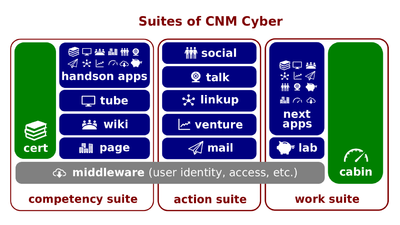CNM Cloud Databases
Databases of CNM Cloud (hereinafter, the Lectio) is the lesson part of the Cloud Foundation Essentials lesson that introduces its participants to CNM Cloud. This lesson belongs to the Introduction to CNM Cloud session of the CNM Cyber Orientation.
Content
The predecessor lectio is What the Foundation Is.
Key terms
Script
- In information technology, any database is the collection of data that is stored and can be accessed digitally by an authorized software system. If special applications can handle their data, software repositories may serve as databases. However, the overwhelming majority of databases represent database management systems (or DBMSes). Usually, a DBMS not only stores and returns, but also capture and analyze the data.
- The CNM Cloud Foundation features two types of database management systems.
- One type utilizes relational model. Relational database management systems (RDBMSes) strictly organize their data. It is stored in tables and the tables are inter-connected in specified ways. Structured query languages {SQLs) are used to retrieve the data from relational databases of CNM Cloud.
- Distributed Database Management System (DDBMS) is another type. This type relies on NoSQL model. NoSQL refers to not-only-SQL. Its data is loosely organized, so makes its management quicker, but less reliable than data management in relational models.
WorldOpp Middleware collects most important data from various systems throughout the CNM Cloud Foundation, transforms the collected data in a unified format, and stores the data in its NoSQL database. The CNM Cyber Team decides on what data shall be collected, transformed, and stored.
- To secure data from disasters such as computer failures and other data loss events, all the data is backed up at the same time every day. At CNM Cloud, that means that the database data is copied and stored separately from the computing server on which the database is installed. In that way, the data backup wouldn't be destroyed if one server collapses.
- For different systems, the backup policies may vary, but the backup system always contains several copies of all data that the CNM Cyber Team considers worth saving. For instance, the system may contain backups that were made yesterday, a day before yesterday, last week, and last month. Commonly, one "old" backup is deleted when one new backup is made.
- As a disaster recovery, any data copy can substitute the original data in the database. However, no data backup cannot restore the data that have been created after the backup was made.
Data in the Foundation is the successor lectio.
Questions
Lectio quiz
- The answer is recorded for the lectio completion purpose:
- CNM Cabin is hosted by:
- CNM Cloud Next
- WorldOpp Federated Servers
- CNM Fellow Servers
- CNM HandsOn Servers
- None of the other answers is correct.
- Which statement below is correct:
- CNM Cyber may include three identical CNM apps.
- While taking this course, you work on the CNM Fellow Servers.
- Future administrators of CNM apps get hands-on training at the CNM Cloud Next.
- All of the other substantive answers are correct.
- None of the other answers is correct.
- CNM Cabin is hosted by:
